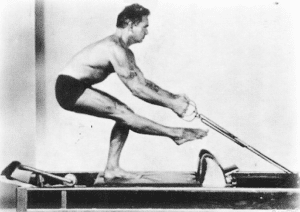A Beginner’s Guide to Pilates
What is Pilates?
Pilates is a form of low-impact exercise designed to connect the body and mind while improving strength, flexibility, mobility, stability and core control. Check out our Youtube channel for pilates exercises.
Meet Joseph Pilates
As a child, Joseph suffered from many illnesses that left him weak and sickly. Inspired by the Greek teaching of balanced mind, body, and spirit, Joseph began to develop an exercise routine based on these concepts. After many years of practicing what we now call Pilates, he went on to become a strong athlete an avid skier, diver, gymnast, and boxer.
In 1962, Joseph and his wife Clara moved to New York City and opened their first fitness studio. They worked closely with the New York City Ballet as the practice of Pilates began to grow. Today, over 11 million Americans practice Pilates and it has become popular in training programs of elite athletes all over the world, including the NFL, NBA, MLB, MLS, NHL and many Olympic athletes.
Pilates Equipment
In Pilates, equipment can be used to provide resistance or assistance during a particular exercise. This type of spring system allows clients of all ages, activity levels, and pain levels to have a exercise experience without placing stress on the body. Pilates equipment includes: mat, reformer, trapeze table, chair, ladder barrel, and spine corrector.
Fun fact: the idea for the Pilates Reformer originated during World War I when Joseph Pilates adjusted the springs on hospital beds to allow bedridden patients to exercise. Researchers believe this ability to exercise helped save the lives of many of his patients when an influenza outbreak struck England in 1918.
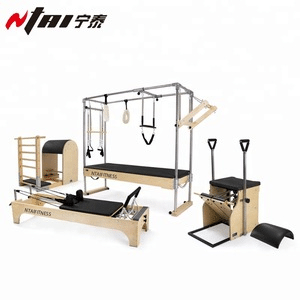
Improve mobility, flexibility, and more through Pilates
- Improve posture
- Pilates helps to increase strength, flexibility, and spinal mobility which contribute to improvements in posture and postural endurance.
- Improve breathing capacity
- Improve mobility
- Controlled breathing with activation of the diaphragm and deep abdominal muscles helps to improve efficiency of breathing.
- Increased strength and control of the core “powerhouse” (muscles of the abdomen, back, and pelvic floor)
- Improve sport performance
- Pilates helps to increase flexibility, balance, strength, and stability which will in turn athleticism
- Researchers found that a 12 -week Pilates training program improved 5K run performance in trained runners
- Pilates has also been shown to improve performance in sports including football, golf, tennis, swimming, baseball, soccer, hockey, and basketball
- Improve mental health
- Research shows that improving posture leads to reduced levels of depression, improved energy levels, and improved mood
- Research shows that Pilates can increase brain functions such as memory performance
- Increase weight loss
- A 50-minute Pilates class can burn between 300 and 500 calories.
- Reduce low back pain
- 80% of american adults experience low back pain each year. Pilates exercises target key contributors to low back pain such as lumbar stability, mobility restrictions, and decreased core strength
Using Pilates for Strength and Stability
Pilates is a compliment to physical therapy due to the low-impact and stability and flexibility exercises. At Symmetry Physical Therapy, we use Pilates exercises to retrain the nervous system and the muscle system in an unfamiliar relationship to gravity. By reducing the demands of gravity and adding support with the spring system, patients are able to perform strengthening and stability exercises without pain or stress on the joints. Eventually, the body begins to normal activities such as squatting, bending, and lifting become less painful. Continue reading for a sample of Pilates exercises that can be performed at home without any equipment.
Common Pilates Exercises
Pelvic Clock
Begin lying on your back with both knees bent. Imagine your pelvis as a clock and begin rocking from 12 to 6, then from 3 to 9.
Benefits: reduces muscle guarding around the pelvic girdle to increase mobility in hips
and lumbar spine.

Pelvic Clock
Bridging
Begin by lying on your back with both knees bent. Perform a posterior pelvic tilt as you
begin to lift your hips off the floor. Move slowly, lifting one vertebrae at a time until the hips are off the floor. Avoid hyperextension by keeping the ribcage closer to the floor.
Benefits: improve spine articulation and posterior chain strength
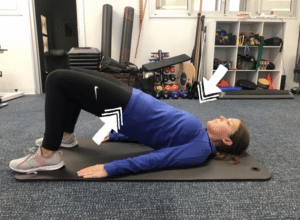
Bridge pose
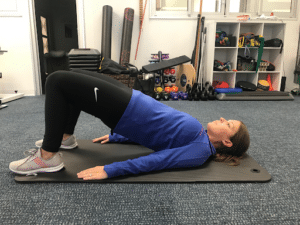
Tighten glutes and core while performing this exercise
Dead Bug
Begin lying on your back with your arms extended towards the ceiling and the hips and
knees bent to 90 degrees. Keep your core engaged and your spine in neutral as you extend opposite arm and leg away from the center.
Benefits: improve core and lumbopelvic stability
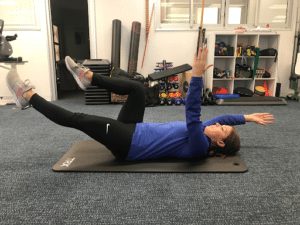
Dead bug exercise
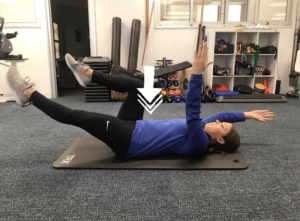
Alternate arm and leg movements while keeping core tight and back flat on the mat
Hundred
Begin lying on your back with your arms by your hips and your legs extended. Curl your
head and upper spine of the floor to the base of your shoulder blades. Next, lift and extend your legs long as you begin pumping your arms. Inhale for 5 arm pumps and exhale for 5 arm pumps. Continue for 10 cycles.
Benefits: improve abdominal strength and breathing capacity
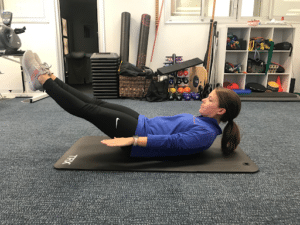
Hundred pose
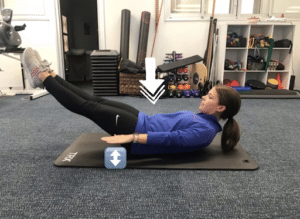
Pump arms up and down with hundred pose
Scarecrow
Begin lying on your stomach with your palms down and elbows and shoulders at 90 degrees. First, lift palms while keeping wrists in neutral. Next, lift elbows while gently squeezing shoulder blades down and back. As you lift your elbows, begin to lift the chest into thoracic extension. After that, extend elbows and reach hands overhead while keeping space between the shoulders and ears. Switch direction and place palms on the floor last.
Benefits: increase strength and overhead stability of shoulders
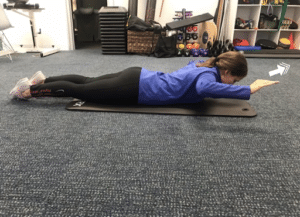
Scarecrow pose with elbows bent
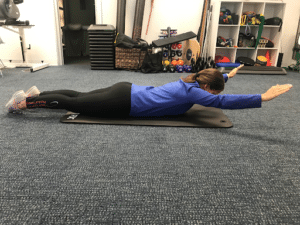
Scarecrow with arms extended

